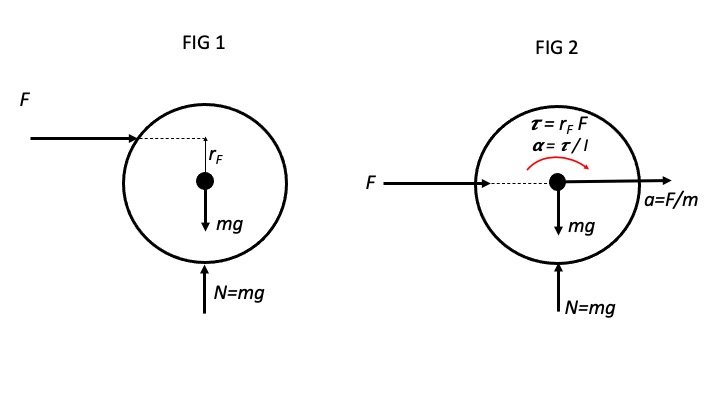Does it roll or slide forward
It depends on where the force is applied and the moment of inertia of the wheel, together which determine whether or not the conditions for rolling without slipping are met without the need for friction.
Fig 1 shows the forces acting on the wheel in the absence of any friction (static, kinetic, or rolling) or air drag, where the line of action of the force $F$ is an arbitrary distance $r_F$ above the center of mass of the wheel (assumed the geometric center). The weight of the wheel is balanced by the normal reaction force of the surface it is on. The only external horizontal force acting on the wheel is $F$ whose line of action is a distance $r_F$ from the center.
Fig 2 shows the equivalent force system where the line of action of $F$ is moved to the center of mass (COM) with a couple (torque) about the COM accounting for the original torque of $F$ about the COM. The wheel has a linear and angular acceleration as shown (where $I$ is the moment of inertia of the wheel about the COM).
The condition for rolling without slipping is, where $r$ is the radius of the wheel
$$a=\alpha r\tag{1}$$
This is based on the distance travelled by a point on the surface of the wheel for a complete revolution has to equal the horizontal distance traveled by the COM in order for there to be no relative motion (slipping) between the wheel and the surface.
Then since
$$\alpha=\frac{\tau}{I}=\frac{r_{F}F}{I}\tag{2}$$
Where $I$ is the moment of inertia about the COM
and $$a=\frac{F}{m}\tag{3}$$
substituting equations (2) and (3) into (1) we have
$$\frac{F}{m}=\frac{rr_{F}F}{I}\tag{4}$$
The moment of inertia $I$ of the wheel will be $I=kmr^2$ where $k\le 1$ depending on the distribution of the mass of the wheel about its
COM. thus equation (4) becomes
$$\frac{F}{m}=\frac{rr_{F}F}{kmr^2}\tag{5}$$
which simplifies to
$$\frac{r_{F}}{kr}=1\tag{6}$$
for a thin walled disk (hoop) $k=1$ and $r_{F}/r=1$. So if the force $F$ is applied to the rim of the hoop, the hoop will roll without slipping. For a solid disk $k=1/2$ and the disk will roll without slipping if the force is applied at half the radius from the COM. And so forth. Otherwise the wheel will slip while rolling.
Hope this helps.





